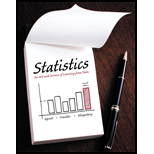Solutions for Statistics: The Art and Science of Learning from Data (4th Edition)
Browse All Chapters of This Textbook
Book Details
Statistics: The Art and Science of Learning from Data, Fourth Edition, takes a conceptual approach, helping students understand what statistics is about and learning the right questions to ask when analyzing data, rather than just memorizing procedures. This book takes the ideas that have turned statistics into a central science in modern life and makes them accessible, without compromising the necessary rigor. Students will enjoy reading this book, and will stay engaged with its wide variety of real-world data in the examples and exercises.
The authors believe that it's important for students to learn and analyze both quantitative and categorical data. As a result, the text pays greater attention to the analysis of proportions than many other introductory statistics texts. Concepts are introduced first with categorical data, and then with quantitative data.
Sample Solutions for this Textbook
We offer sample solutions for Statistics: The Art and Science of Learning from Data (4th Edition) homework problems. See examples below:
More Editions of This Book
Corresponding editions of this textbook are also available below:
